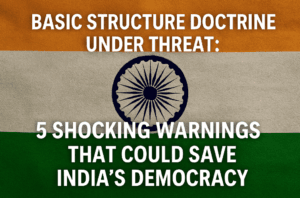Basic Structure Doctrine Under Threat: 5 Shocking Warnings That Could Save India’s Democracy
At a discussion marking the release of Justice Rohinton Nariman’s book on India’s Basic Structure Doctrine, Senior Advocate Kapil Sibal issued a grave warning: the Constitution’s foundational principles—secularism, federalism, and democratic accountability—are being eroded through ordinary legislation, bypassing constitutional amendments. While the doctrine (enshrined in the landmark Kesavananda Bharati case) shields the Constitution’s core from parliamentary overreach, Sibal highlighted a critical loophole: ordinary laws violating its “basic structure” face limited judicial scrutiny, as they can only be challenged under Fundamental Rights (Article 13), not the doctrine itself.
This legislative sleight of hand, he argued, allows systemic dilution of constitutional values without formal amendments. Legal experts diverged on solutions—Senior Advocate Abhishek Singhvi urged revisiting precedents restricting Basic Structure challenges to amendments, while Arvind Datar cited rulings where courts invalidated ordinary laws for undermining constitutional essence.
The debate underscores a pivotal struggle: as laws centralizing power or marginalizing minorities test India’s democratic fabric, the judiciary’s role as the doctrine’s “gatekeeper” grows urgent. The event echoed a broader call for judicial courage and public vigilance to protect what Justice AK Sikri termed the “heartbeat of India’s democracy”—a battle not just for legal clarity, but for the soul of constitutional governance.

Basic Structure Doctrine Under Threat: 5 Shocking Warnings That Could Save India’s Democracy
At the launch of Justice Rohinton Nariman’s book, The Basic Structure Doctrine, Senior Advocate Kapil Sibal delivered a stark warning: India’s constitutional bedrock is under siege. His remarks, echoed by legal luminaries, ignited a critical discourse on safeguarding the Constitution’s essence in an era of legislative overreach.
The Fragility of Constitutional Safeguards
Sibal argued that while the Basic Structure Doctrine—established in the landmark Kesavananda Bharati case (1973)—remains legally inviolable, its spirit is being eroded through ordinary legislation. Unlike constitutional amendments, which courts can strike down for violating the doctrine, everyday laws face no such scrutiny. “You can hollow out the Basic Structure without amending the Constitution,” Sibal cautioned, pointing to laws that undermine federalism, secularism, and democratic accountability.
This loophole stems from a legal Catch-22: While constitutional amendments are subject to Basic Structure review (per Kesavananda), ordinary laws can only be challenged under Article 13 if they contravene Fundamental Rights (Part III). Courts, Sibal noted, have been reluctant to invalidate such laws, enabling systemic violations.
A Battle for Judicial Vigilance
The event underscored a tension between legislative power and judicial guardianship. Former Supreme Court Justice AK Sikri affirmed the doctrine’s permanence, emphasizing India’s identity as a “liberal democracy” where majority rule cannot override constitutional principles. Yet, Senior Advocate Abhishek Manu Singhvi highlighted a paradox: Judges, as “gatekeepers” of the Constitution, hold ultimate interpretive authority, yet current jurisprudence limits their ability to curb ordinary laws infringing on the Basic Structure.
Singhvi urged revisiting precedents like the Indira Gandhi v. Raj Narain case (1975), which restricted Basic Structure challenges to constitutional amendments. Conversely, Senior Advocate Arvind Datar countered that some rulings, such as those by Justice VR Krishna Iyer, have allowed ordinary laws to be struck down for violating constitutional essence, suggesting flexibility in judicial interpretation.
Historical Echoes and Global Resonance
Sibal’s recollection of witnessing Nani Palkhivala argue the Kesavananda case as a young lawyer underscored the doctrine’s legacy. The ruling not only redefined India’s constitutional framework but also inspired over 20 nations to adopt similar safeguards against absolute parliamentary power. Singhvi noted this global influence, urging pride in India’s legal innovation while cautioning against complacency.
Implications for Democracy
The debate transcends legal technicalities. If legislatures can bypass the Basic Structure through ordinary laws, core tenets like judicial independence, minority rights, and federal balance risk dilution. For instance, recent laws criticized for centralizing power or marginalizing communities exemplify this threat. Sibal’s warning—that courts are failing to act as robust checks—raises urgent questions about preserving constitutional morality in a polarized climate.
The Path Ahead
The conclave called for renewed judicial courage and public awareness. As Justice Nariman’s book illuminates, the Basic Structure Doctrine is not merely a legal principle but a covenant with citizens. Its survival hinges on judges’ willingness to expand its scope to ordinary laws and citizens’ demand for accountability.
In Sibal’s words, the doctrine is “here to stay,” but its vitality depends on vigilant enforcement. As India navigates evolving democratic challenges, the event served as a rallying cry: To protect the Constitution’s soul, the judiciary and civil society must unite as custodians of its Basic Structure.
Final Insight
The discussion mirrors a global struggle to balance majority rule with constitutional integrity. India’s experience offers both a cautionary tale and a blueprint—a reminder that even the strongest democracies require unwavering commitment to their foundational values. The Basic Structure Doctrine, as Justice Sikri asserted, is more than law; it is the heartbeat of India’s democracy. Preserving it demands not just legal acumen but collective resolve.
You must be logged in to post a comment.